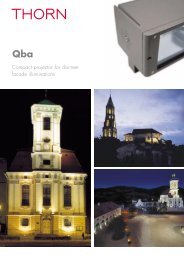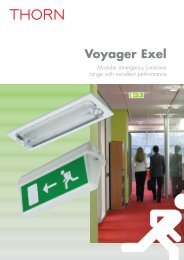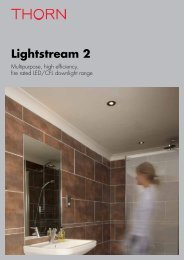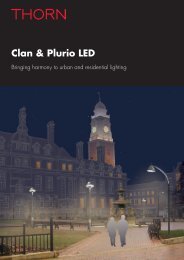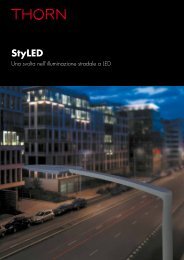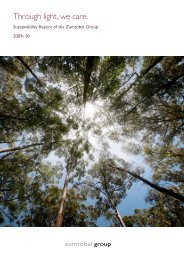Lighting for Education - THORN Lighting
Lighting for Education - THORN Lighting
Lighting for Education - THORN Lighting
- No tags were found...
Create successful ePaper yourself
Turn your PDF publications into a flip-book with our unique Google optimized e-Paper software.
Green MattersFor every kWh of energy 0.42 kg of CO 2 isemitted and added to the ‘greenhouse’ gases inthe atmosphere, increasing global warming.SustainabilityHow does sustainability affect lighting in education?Green mattersRecent studies have estimated that European schools contribute15% of the public sector carbon footprint.These estimates assume approximately 20-30% of energy usecomes from artificial lighting in schools.Thorn has made a commitment to sustainability, the long-termconservation of our ecosystem and the responsible use of finiteresources. With commitment comes consequences. The balancebetween the demands <strong>for</strong> energy savings and the different needsof human beings and the conservation of the human habitat, whichinvolves social aspects of a more sweeping significance.Energy efficiencyThorn is committed to optimise the use of energy by supplyingtechnically innovative, intelligently controlled luminaires andcomponents compatible with eco-design and planning.Today the fluorescent lamp, both linear and compact, operated bythe electronic ballast is the most efficacious light source. Solid stateLEDs are making significant progress as a potential energy savingalternative with 50,000 hours rated life, no UV or IR emissionsand will contain no mercury. Lamps are only part of the story.A sustained increase in light output ratio (LOR) can be achievedthrough improved luminaire design and innovative reflectormaterials.<strong>Lighting</strong> controls, e.g. presence- and daylight-linking as well asdimming, add much to operational efficiency. Energy is savedby providing electric light where and when it is needed. Daylightsensing and the presence detection of people can produce up to80% energy savings without jeopardising the quality of the requiredlighting conditions.In addition to lamps, luminaires and control systems, an optimumlighting concept and planned maintenance programme are factorsto greater sustainability in educational lighting. At Thorn we adopta responsible approach to the environment and natural resources.We have installed a programme to certify all of our productionfacilities to ISO 14001 that applies to our use of materials andproduction processes.Concluding thoughtsClimate change has the potential to undermine the future prosperityand life chances of children and young people. If we lay thefoundations <strong>for</strong> more equal opportunities and more equal shares,do we have a chance of making peaceful progress. This starts withthe education of our children.Sustainable development is now a compulsory part of many schoolcurriculums. Schools have enlisted pupils to study energy meters,pledge to change light bulbs to more efficient sources and placenotices on switches urging people to turn off unwanted lights, all toconsiderable effect.4
How to avoid obtrusive lightLight sourcesBallastsLuminaires<strong>Lighting</strong> ControlsScheme concept5
Standards and legislationStandards and legislationThorn products fully meet the EN 60598 product standard andcon<strong>for</strong>m to the ENEC mark licence requirements. The companyholds the ENEC 25554 licence <strong>for</strong> many products. Its technical staffare also active in international standards ISO, IEC, CIE, Europeanstandards CEN, CENELEC and BSI standards. Thorn is also amember of CELMA.Following the Kyoto agreement the EU has set targets to reducecarbon emissions by 20% from 1990 levels by 2020. To supportthis process a raft of directives and standards have been produced.For lighting these include:• Energy Efficiency Labelling of Products Directive (ELP)• Energy use Products Directive (EuP)• Energy Per<strong>for</strong>mance of Buildings Directive (EPB)• Waste of Electrical and Electronic Equipment Directive (WEEE)• Restriction of Hazardous Substances Directive (RoHS)• Battery and Accumulators Directive (B&A)• Packaging of Products Directive (PoP)6
How to avoid obtrusive light7
Objectives site mapA school building is a facility that aids andpromotes learning, the lighting shouldsupport this aim.Sports HallsMain objectives are to ensure that students and staff have adequatelight to safely participate in sporting activities. These may requirevisibility of relatively small objects moving at high speed, or visualconditions suitable <strong>for</strong> the use of gymnastic equipment.see pages 20 and 21Corridors and StaircasesMain objective is to allow studentsand staff to move around thebuilding safely. As corridors andstaircases are also main exit routes<strong>for</strong> emergency situations goodemergency lighting with wayguidanceis necessary.see pages 14 and 15Entrance HallsMain objective is to provide visitorswith a visible first point of contactand students and staff with atransition zone from exterior andinterior lighting levels.see pages 12 and 13OutdoorMain objective is to provide sufficientlighting <strong>for</strong> orientation and directionwith security after dark.see pages 22 and 238
How to avoid obtrusive lightClassroomsMain objectives are to ensure that students and staff have adequatelight to per<strong>for</strong>m their tasks (such as reading, writing), that studentscan see any teaching aids used (such as a whiteboard/blackboard orprojected in<strong>for</strong>mation), that modelling is suitable to allow goodcommunication between students and staff. see pages 10 and 11Laboratories andWorkshopsMain objectives are to ensurethat students and staff haveadequate light to per<strong>for</strong>mtheir tasks (such as scienceexperiments or craft projects)and that the lighting aids goodvisibility and there<strong>for</strong>e safety.see pages 18 and 19Assembly HallsMain objectives are to produce a suitable visual environment <strong>for</strong> allactivities required within the space. These may be school meetings,rehearsals and per<strong>for</strong>mances of school productions, a space <strong>for</strong> <strong>for</strong>malwritten examinations, or others. see pages 16 and 179
ClassroomsClassrooms are at the heart of the learningprocess. The lighting must be flexible enoughto supply the correct amount of light <strong>for</strong> thetasks of the day.classroomsPer<strong>for</strong>mance – The lighting objective <strong>for</strong> a classroom is to helpcreate the right environment <strong>for</strong> learning. Tasks are generally carriedout on desks, tables and wall spaces, using text books, computersand whiteboards/blackboards. Teachers and pupils interact,and faces and body language need to be seen, there<strong>for</strong>e goodhorizontal and vertical lighting is essential. Vertical illuminanceprovides good modelling to enable teachers to communicate withclearly understood facial expressions. This is critical <strong>for</strong> students withimpaired hearing, relying on lip reading or signing.<strong>Lighting</strong> in the classroom should be flexible and controllable. Whendesigning <strong>for</strong> the space, ambient, task and accent lighting shouldbe considered. Ideally lighting controls enabling to adapt lightingwhen using audio-visual equipment, and dedicated lighting <strong>for</strong>whiteboards/blackboards to ensure clarity, should also be used.Efficiency – It is common <strong>for</strong> a classroom to have significantamounts of daylight. <strong>Lighting</strong> controls with daylight sensing shouldbe used to reduce power demand and conserve energy. Of equalimportance is absence and presence detection to turn lights off whenthe classroom is empty or zoned teaching areas within a largerspace.Com<strong>for</strong>t – <strong>Lighting</strong> of the ceiling and walls ensures the space hasa balanced ambience. Contrasting the proportions of upward lightto downward light varies the feel of the space, allowing a calm orlivelier atmosphere. Accent lighting of wall displays and handicraftsprovides further variety and interest.<strong>Lighting</strong> requirementsMaintainedilluminance (E m)Limiting glare value(UGR L)Colour renderingindex (Ra)300 - 500lx 19 80NB. 300 lx is a suitable maintained illuminance level <strong>for</strong> youngerstudents per<strong>for</strong>ming general tasks. 500 lx is a suitable maintainedilluminance level <strong>for</strong> adult education classes or <strong>for</strong> smaller or moredemanding tasks.Techniques<strong>Lighting</strong> with a tightly controlled down light component, <strong>for</strong> examplespecular louvre fittings or small recessed downlights, should beavoided. This leads to overly strong modelling and harsh shadows.When DSE or LCD flat screen technology is present, luminaires withmedium levels of optical control are suitable. This level of control isnormally sufficient to ensure there are no sharp contrasts, caused bythe artificial lighting, to appear on the display screen. DSE shouldnot dictate the lighting requirements of the classroom as they mayonly be used <strong>for</strong> limited periods of time.Whiteboards/blackboards should be positioned to avoid the teacherappearing in silhouette against the surface, this will reduce thevisibility of the teachers face. If audio-visual projectors are used theluminaires should be positioned not to impede the projector image.10
SENSAMODULARQVINTUS LINE XSOPTUS IV MENLOSOFTPLANOR C PLANOR RRalph Thoresby School, Leeds, UKOstervala School, SwedenUsworth Sixth Form College, UKMalmo Hogskola, SwedenMédiathèque, France11
Entrance HallsThe power to impress and a showcase <strong>for</strong>achievements.ENTRANCE HALLSPer<strong>for</strong>mance – The reception area provides visitors with afirst point of contact, and <strong>for</strong> students and staff a transition zonebetween interior and exterior lighting levels. Light attracts people, awell lit reception area and reception desk will help orientate visitorsunfamiliar with the building.Efficiency – Poorly maintained lighting in a school buildingprojects an image of neglect and generates apathy from studentsand staff. Ease of luminaire maintenance is a priority and criticalin the reception area. Whilst energy efficiency is always important,consideration must be given to appearance. The use of luminairesdesigned to be sustainable and attractive should be the aim.Com<strong>for</strong>t – The reception area is a showcase <strong>for</strong> the school and anopportunity to project its attitudes and beliefs. A relaxed welcomingfeel to the space will reassure visitors and students new to thebuilding. The lighting should be used to help create an inspirationalspace and leave visitors with an impression of the values of theschool. For the students it will be an ideal start to the day.<strong>Lighting</strong> requirementsMaintainedilluminance (E m)Limiting glare value(UGR L)Colour renderingindex (Ra)200 lx 22 80TechniquesEntrance halls and reception areas lend themselves to the use ofdownlights, wall washers and decorative uplighters to create avibrant atmosphere. Decorative suspended luminaires or recesseddownlights are synonymous with the reception desk. Entrances withhigh ceilings are well served by the use of upward and downwardlight distribution from suspended luminaires.Spotlights may be added to highlight awards, works of artor signage.12
SENSAMODULARTHAMES GLACIER IIBASE LEDCOLLEGE CRUZ PRISMARalph Thoresby School, Leeds, UKAalborg, DenmarkLeeds University Innovation Hub, UKMalmo Hogskola, SwedenVicenza, Italy13
Corridor and StaircasesCirculation spaces are the necessary network ofcorridors and stairs that allows the safe passage ofpeople throughout the building.CORRIDOR AND STAIRCASESPer<strong>for</strong>mance – Corridors and stairs are defined as circulationspaces to enable students, staff and visitors to move around thebuilding safely. Good lighting cannot guarantee safety, but poorlighting does increase the risk of accidents. The lighting needs to beglare free with special attention given to changes in levels such asstaircases and ramps. The lighting should bring emphasis to areas ofpotential danger by producing contrast on surfaces allowing peopleto easily identify the risks. Circulation areas are the main exit routesin an emergency and must be protected with emergency lighting andway-guidance systems.Efficiency – There is little traffic in circulation areas <strong>for</strong> long periodsof the school day. A lighting control system with presence detectionwill greatly reduce electricity consumption. Circulation areas aregenerally well served by daylight. It is an advantage to be able todim the artificial light manually or by daylight sensing to improveenergy efficiency. Quick and easy maintenance of the luminairesinstalled in these areas is a prerequisite to sustainability.Com<strong>for</strong>t – A well lit corridor and staircase is a safe and welcomingenvironment in which students, staff and visitors can navigate theirway around the building. Brightly lit ceilings, walls and floors willmake the space seem open, appealing and com<strong>for</strong>table movingfrom one place to another.<strong>Lighting</strong> requirementsMaintainedilluminance (E m)Limiting glare value(UGR L)Colour rendering index(Ra)100 lx 25 80TechniquesWall mounted uplighters or suspended luminaires with an upwardand downward lighting component will produce well lit ceilings,walls and floors.Recessed or surface mounted wall washing luminaires should beconsidered <strong>for</strong> effect or the practical illumination of wall displaysand artwork.14
SWITCHLITEVOYAGER SIGMAVOYAGER LED THAMES BASE LEDCOLLEGE CRUZ PRISMARalph Thoresby School, Leeds, UKEllekilde, Denmark Vardean College, UKVardean College, UKEga, Denmark15
Assembly HallsMaking speeches, theatre and concerts,examinations, lighting <strong>for</strong> all.ASSEMBLY HALLSPer<strong>for</strong>mance – Assembly halls are generally multi-purpose spaceswith diverse activities, requiring equally flexible lighting systems.The hall may be used throughout the school year <strong>for</strong> speech days,visitor presentations, music and drama, external public meetingsand examinations. As an example, examinations require good taskvisibility and contrast without glare or shadowing of papers. Thiswill reduce fatigue, hopefully resulting in fewer errors and greatersuccess.Efficiency – High ceilings can be a feature of assembly hallsmaking access to lighting difficult and expensive. However, a welllit environment must be maintained to present the right impression tovisitors, staff and pupils. <strong>Lighting</strong> controls with scene setting shouldbe employed <strong>for</strong> the activity in progress. Poorly controlled lightingleads to lights being turned on, wasting energy and providing a lessefficient lit environment.Com<strong>for</strong>t – The assembly hall is at the heart of a school and is acelebrated space projecting the school ethos, its successes and itsambitions. The lighting should reflect these values and engender asense of calm when required and exuberance when the school ispresenting a public face.<strong>Lighting</strong> requirementsMaintainedilluminance (E m)Limiting glare value(UGR L)Colour rendering index(Ra)200 lx 22 80300 - 500 lx 19 80TechniquesThe objective in lighting these often large and sometimes highceiling rooms, is to eliminate a gloomy and oppressive atmosphere.Managed by a lighting control system, downlights in combinationwith wall washers or uplighters will light the surfaces of the spacewell. Suspended luminaires with an upward and downward lightingcomponent would be the choice <strong>for</strong> very high ceilings.Spotlights may be used to highlight items of interest, such as roles ofhonour, awards and works of art.16
SENSAADVANCEDTHAMESGLACIER IICONCAVIA SCOLLEGECRUZRalph Thoresby School, Leeds, UKVardean College, UKUsworth Sixth Form College, UKWarsaw, Poland17
Laboratories and WorkshopsSpecialist areas where health and safetyare paramount.Laboratories and WorkshopsPer<strong>for</strong>mance – Good task visibility is critical in areas wherethere is a potential hazard from machinery and tools, laboratoryequipment and chemicals. Multiple light sources should beemployed to remove shadowing which could reduce visual clarity.A good flow of light is essential to prevent errors of judgement anderrors of identification.Efficiency – The lighting design objective is to provide maximumvisibility <strong>for</strong> teachers and students. The luminaires must be robust,IP rated and IK rated as chemical resistance is essential. <strong>Lighting</strong>controls are discouraged to prevent the possibility of an unexpectedfailure resulting in a hazardous situation.Com<strong>for</strong>t – In laboratories and workshops it is important that thelit environment produces a balanced ambience with no sources ofglare or harsh contrasts. The lighting should help promote safety bycreating a calm atmosphere, helping students concentrate onthe task.<strong>Lighting</strong> requirementsMaintainedilluminance (E m)Limiting glare value(UGR L)Colour rendering index(Ra)500 lx 19 80TechniquesLaboratories and workshops are <strong>for</strong>mal teaching areas and mustbe lit with a good vertical illuminance. This can be achieved fromluminaires with prismatic diffusers which also produce an evenspread of light. Luminaires must be positioned to take into accountthe layout of the machinery and equipment within the space, toensure the most efficient and safe environment. Localised tasklighting may be required <strong>for</strong> areas containing specialised equipmentand machinery.18
AQUAFORCE PRISMACOLLEGEOPTUS IV OPTUS IV IP23Ralph Thoresby School, Leeds, UKRalph Thoresby School, Leeds, UKEllekilde, DenmarkVardean College, UK19
Sports HallsA sports hall is a multi-functional space allowing<strong>for</strong> a wide range of activities.Sports hallsPer<strong>for</strong>mance – Sports halls are designed <strong>for</strong> a number of differentsports, occasionally to be played at the same time. People andobjects moving at high speed, badminton nets and gym equipmentin position, officials judging, spectators cheering. Light needs to fillthe whole space with good vertical illuminance and glare controlfrom the luminaires. Safety when participating is paramount.The ability to see a moving ball against the hall background andto distinguish individuals and team colours are required from asuccessful lighting scheme.Efficiency – The lighting must operate to provide maximumvisibility. The luminaires must be robust and protected, possiblywith wire guards, and fitted with long life lamps. Access to theseluminaires can be difficult and costly. The installation should beflexible, possibly using lighting controls, to ensure lighting can beadjusted to suit the appropriate activity.Com<strong>for</strong>t – The primary objective of the lighting is to create anexhilarating, safe space to help motivate the competitors. A wellbalanced illuminance is important to prevent unwanted contrast orglare from reducing visibility to those playing.<strong>Lighting</strong> requirementsThese vary depending upon the sports being played and therelevant criteria should be derived from the standard EN 12193Light and <strong>Lighting</strong> – sports lighting.TechniquesCare should be taken with the positioning of the luminaires, toprevent glare obstructing a players visibility looking up when a ballor shuttlecock is hit high.Lobay luminaires with a fairly wide beam and dedicated sportsluminaires work efficiently and effectively in this space. Thepossibility of condensation in a cool or unheated hall should beconsidered when selecting luminaires.20
SENSAMODULARSENSAMODULARTITUS SPORTDojo à Forges les eaux, France © Pascal PhotographieTennis Hall, Thorigné Fouillard, France © Studio PilamLeisure Centre, Boson SwedenVardean College, UKOasis Academy, Grimsby, UK21
OutdoorDesign by day, light by nightOUTDOORPer<strong>for</strong>mance – Outdoor lighting presents a fresh set of challengeswith safety and security being the prime objectives. The light shouldbe sufficient <strong>for</strong> people to navigate safely at night, with goodvertical illuminance and a wide distribution.Efficiency – Outdoor luminaires should be architecturallycompatible with the building and landscape. The luminaires mustbe fit <strong>for</strong> purpose and maintained to a high level to remove theimpression of neglect in an area. Outdoor luminaires should beIP rated and IK rated <strong>for</strong> environmental conditions and vandalism.Outdoor lighting should also utilise lighting controls to conserveenergy. Dimming or selective switching of some luminaires whenappropriate help reduce power demand. The control of upward lightpollution is a further step on the path to sustainability.Com<strong>for</strong>t – Safe and reassuring, pleasant and welcoming arethe tenants of successful outdoor lighting. Playgrounds, pathways,entrance areas and car parks will all benefit from an eco-conscienceapproach to visibility outdoors.<strong>Lighting</strong> requirementsMaintainedilluminance (E m)Limiting glarevalue (UGR L)Colour renderingindex (Ra)Uni<strong>for</strong>mity(Uo)Parking 5 lx 55 20 0.25Pathway 5 lx 50 20 0.25TechniquesEfficient and effective per<strong>for</strong>mance combined with an aestheticallypleasing solution is the aim <strong>for</strong> outdoor lighting. Bollards are thepreferred luminaire where vandalism is low, positioned with careto avoid the possibility of accidents. Luminaires on columns shouldbe positioned away from buildings to negate the possibility ofunwanted attempted intrusion.22
JET PLURIO CHAMPION AREAFLOODTROIKAVicenza School, ItalyEgå Secondary School, DenmarkVardean College, UKMount St Marys School, UK23
Case StudyQuinto Vicentino Primary School, ItalyCASE STUDYCompleted in 2008, this primary school links, via a coveredwalkway, to an existing sports hall. It comprises ten classrooms,five special-subject rooms and three workshops. The building alsohas a large multi-purpose hall that serves as the school entrance /cafeteria. The complex is surrounded by greenery and shares itsfacitilites with the local community outside of school hours. Thefaçade design is a deliberate reference to a computer monitor withscreens of coloured pixels.Extensive windows in the classrooms are supplemented bylarge glazed façades and centrally-placed rooflights in themulti-function hall.The electric lighting of a typical 49m² classroom comprises eightrecessed modular MenloSoft luminaires with Prismtec diffusers,each housing twin 24W T16 fluorescent lamps and dimmable highfrequency control gear, in addition to a single 49W T16 OptusIV chalkboard fitting with asymmetric reflector. They provide anaverage illuminance of 386 lux, with a specific load of 9.5 W/m 2 .Classroom lighting is used <strong>for</strong> 1500 hours per year.The double height of the entrance hall called <strong>for</strong> Planor XL, a thin120cm square suspended luminaire, fitted with ten 54W dimmableT16 lamps.Classroom and dining room lighting (80% of the school’s floorarea) is controlled by a SensaModular system, designed on the oldadage “rely on occupants to turn lights on, but not to turn them off”.It comprises of daylight- and absence-linked lighting controls withphotocells and presence detectors, at a cost of € 15,078. The toiletareas employ presence detectors.Annual energy consumed <strong>for</strong> lighting the 18 teaching spaces isestimated at 14,550 kWh and costs approximately € 2,910 peryear. The controls bring about a reduction in the consumption ofelectrical energy of 70%, giving an annual saving € 2,037.With € 2,028 saved on less relamping, the payback period is6.5 years.Externally the emphasis was on individual light points; <strong>for</strong> example,the structural pencils holding the porticos are lit by ground-recessedluminaires, fitted with 35W metal halide lamps. For the bright redwalls the choice was Oyster indirect/direct lights; again using metalhalide.The result is a new generation of educational building. Imaginativeuse of the latest lighting equipment has created an extremelypleasant environment in which to study and play, while the lightingdesign is both aesthetically pleasing and energy conscious.24
Case StudyQuinto Vicentino Primary School, ItalyFACT BOXScheme Associates:Client: Municipality of Quinto VicentinoArchitect: Gianluca PerottoniConstruction management: Ing. Lorenzo Dalla VecchiaElectrical and lighting design: Ing. Matteo MunariSafety coordinator: Ing. Silvia Dall’IgnaTotal project costs: € 2,500,000.00Savings in teaching spacesTypes of lamps: 2 x 24WTypes of luminaire: recessed modulars with diffusersNumber of luminaires: 169Avg Illuminance: 386 lxWattage/luminaires: 9.7kWBurning hours / year: 1,500Annual consumption: 14,550 kWhCostsEnergy cost / year: € 2,910Cost of control system € 15,078SavingsAnnual energy savings from a power reduction of 70%: € 2,037On changing lamps: € 2,028Payback period: 6.5 years26
Everything you need to knowabout lighting in education<strong>Lighting</strong> <strong>for</strong> <strong>Education</strong>: combining per<strong>for</strong>mance, efficiency and com<strong>for</strong>tWhether you’re a specifier, an electrical contractor, or just a curious student, hereyou’ll find a collection of support in<strong>for</strong>mation that will assist you in producing the mostappropriate lighting solution <strong>for</strong> your educational establishment.Since the new millennium we have witnessed a period of rapid technical developmentin the lighting industry, driven by the economic pressures associated with rising energycosts and climate change on the one hand, and changing learning conditions andtasks on the other. With lighting users struggling to keep abreast of these productintroductions (luminaires, lamps, control systems) and legislation coming into effectwe’ve produced this “how-to” Design Guide.Now, Thorn has made it easier<strong>for</strong> you to plan and specify yourlighting with confidence. Thisguide gives you – applicationarea by application area – theknowledge to provide “energyefficient” lit environments withinwhich students, staff and thecommunity can carry out theiractivities easily and com<strong>for</strong>tablyin attractive and stimulatingsurroundings.In the following pages, luminairesand lighting control strategiesare identified, visualisations andregulatory compliant designlayouts shown and essentialequipment lists given, that detailall the products you’ll need tocomplete the task. It puts all thefacts and specifications at yourfingertips, and provides the helpyou need to achieve the desiredper<strong>for</strong>mance, efficiency andcom<strong>for</strong>t <strong>for</strong> educational lightinginstallations.27



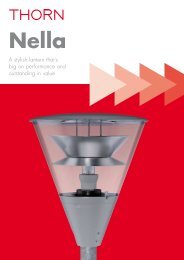
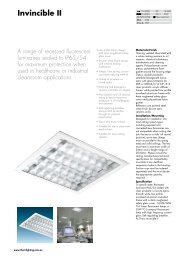
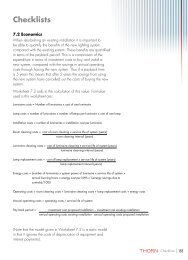
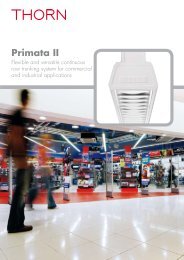
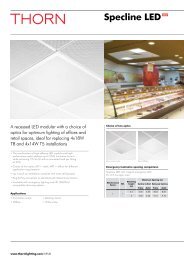

![Produkt brochure [PDF/4MB] - THORN Lighting](https://img.yumpu.com/50705283/1/184x260/produkt-brochure-pdf-4mb-thorn-lighting.jpg?quality=85)
